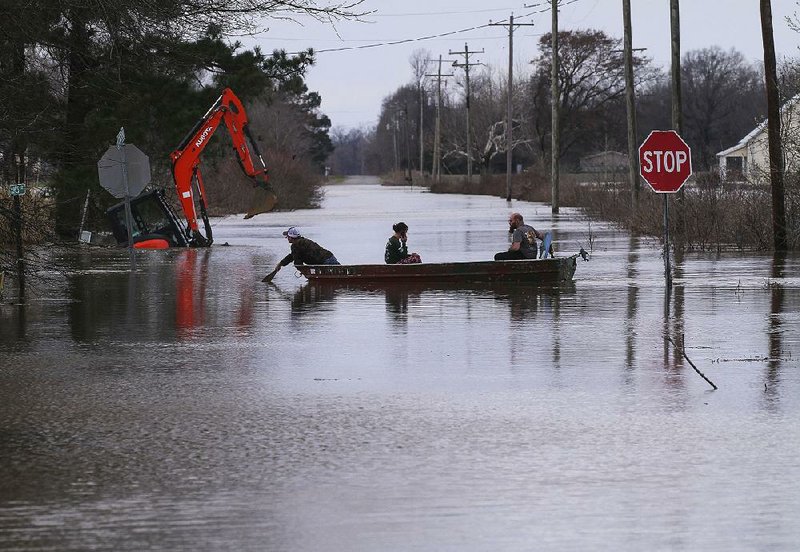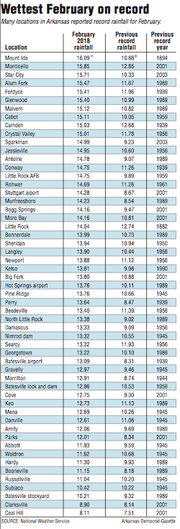Last month appears to be the wettest February in Arkansas since at least 1939 and preliminarily the wettest February since state averages began being tabulated in 1895, according to the National Weather Service in North Little Rock.
Mount Ida in Montgomery County had the most rain in Arkansas last month with 16.09 inches, breaking its previous February record of 10.88 inches set in 1894, according to the weather service. Some unofficial stations reported as much as 18 inches.
Mount Ida Mayor Jo Childress said nearly 12 inches of rain fell over a six-day period beginning Feb. 20.
"We didn't need all that rain," she said. "Come July, we'll be saying 'Where did all that rain go? Where is it now?'"
Click here for larger versions
Photos by Thomas Metthe
Photos by Thomas Metthe
About 50 miles east* of Mount Ida, near Lonsdale, 14 cows and 11 calves were killed when lightning hit an oak tree early Thursday and scorched 100 yards of barbed-wire fence along the Garland and Saline county line.
"They were trying to get away from that heavy rain," Mike Rigsby said of his cattle. "It didn't look like any of them moved a bit. They fell over on the fence, actually, tore the fence down."
Rigsby said the lightning melted the wire, which he found in burned, wadded piles.
"We've been farming for 65 years, and this is the first time I've ever seen anything like this," he said. "It was five or six times louder than normal lightning. It woke me up. I thought, 'Whatever it hit, it hit hard.'"
The storms moved out of Arkansas on Thursday, leaving swollen lakes and rivers in their wake.
Fifty-five locations in Arkansas reported record rainfall for February, according to the National Weather Service, which has more than 100 rainfall monitoring stations in the state. The results are preliminary until they receive final approval by the National Center for Environmental Information in Asheville, N.C.
Mena Intermountain Municipal Airport reported 18.04 inches of rain for February, but the weather service didn't include that number in the official top-55 list.
Mena's other weather station reported 12.69 inches, breaking the February record of 10.26 inches set in 1945.
Fred Ogden, the airport manager, said the difference could be because the airport has a unique weather station.
"Our weather station here at the airport doesn't have a rain gauge per se," he said. "It measures the amount on an hourly basis. I think it measures the amount of moisture in the air. It's called an automated weather observation system."
Either way, it's been wet at the airport.
"Man, it's been a frog strangler, I'll tell you what," Ogden said. "It's surprising everything hasn't sunk into the mud here."
Monticello was second on the list with February rainfall of 15.85 inches, breaking the record of 12.85 inches set in 2001.
Star City in Lincoln County was third with 15.71 inches, breaking its record of 10.33 inches set in 2003.
Little Rock had 14.04 inches of rain last month, breaking the record of 12.74 inches set in February 1882.
It was the wettest winter in Arkansas since 1949-50, according to the weather service. Sparkman in Dallas County led the state in winter 2017-18 rainfall with 27.08 inches.
Childress said the rain was good for Lake Ouachita, which was low before the deluge.
"Our lake is full again," she said. "Thank goodness. It was so far down."
On Feb. 13, the U.S. Army Corps of Engineers was warning of low water levels on Lake Ouachita, which was at 568.07 feet above mean sea level. At noon Thursday, the lake level was at 583.13 feet, said Derick Walker, supervisory ranger at Lake Ouachita.
"It's definitely one of the faster rises we've ever had," he said.
The conservation pool, or peak water storage level, at Lake Ouachita is 578 feet. Anything above that is flood stage, said Walker.
March 1 is the day campsites normally open at Lake Ouachita after being closed for the winter, but Walker said about 75 of the lake's 700 campsites remained closed Thursday because of flooding.
Walker said logs and other debris have washed into the lake, "so boaters need to be aware that there are hazards out there floating."
Miles Brown, a spokesman for the Corps of Engineers in Little Rock, said almost all of the Corps' 12 lakes were experiencing flooding.
"All of our lakes are above conservation pool now, except for Norfork," he said. "It's slightly below."
At 1 p.m. Thursday, Bull Shoals Lake was about 1½ feet over conservation pool level, Greers Ferry Lake was about 7 feet over, and De Queen Lake was 40 feet over conservation pool, Brown said.
"We're working to bring those levels back down by releasing water as channel capacity allows," he said.
Brown said there was an extremely dry period in December and January, and many of the state's lakes were at 75 percent to 80 percent of their conservation pool.
Brown said the lakes are doing what they were designed to do.
"They're holding back these waters," he said. "Their job is to reduce peak flooding downstream."
In Baxter County, Eldon E. Cooper, 49, was rescued Wednesday night after the tractor he was driving slid off the muddy edge of a levee and into a pond north of Mountain Home, trapping him inside.
Cooper spoke to his wife by telephone about 5:10 p.m. Wednesday, according to a news release from the Baxter County sheriff's office. When Cooper didn't meet his wife at church at 6 p.m., she went looking for him and found the tractor on its side in the pond.
The tractor's cab was about three-quarters submerged, Chief Deputy Jeff Lewis said.
"There had been a whole lot of rain here recently," Lewis said. "It was just soft ground and the tractor slid."
Initially, first responders didn't believe Cooper had survived, Lewis said. About 8:30 p.m., sounds were heard coming from inside the tractor, according to the news release. Rescue personnel broke glass in the cab to get Cooper out, Lewis said.
"He was able to keep his head above water to survive," Lewis said. "They said he had ahold of a seat-belt strap that he was using to hold himself above the water. Holding on for dear life."
Metro on 03/02/2018
*CORRECTION: A previous version of this story misstated the location of Lonsdale.

